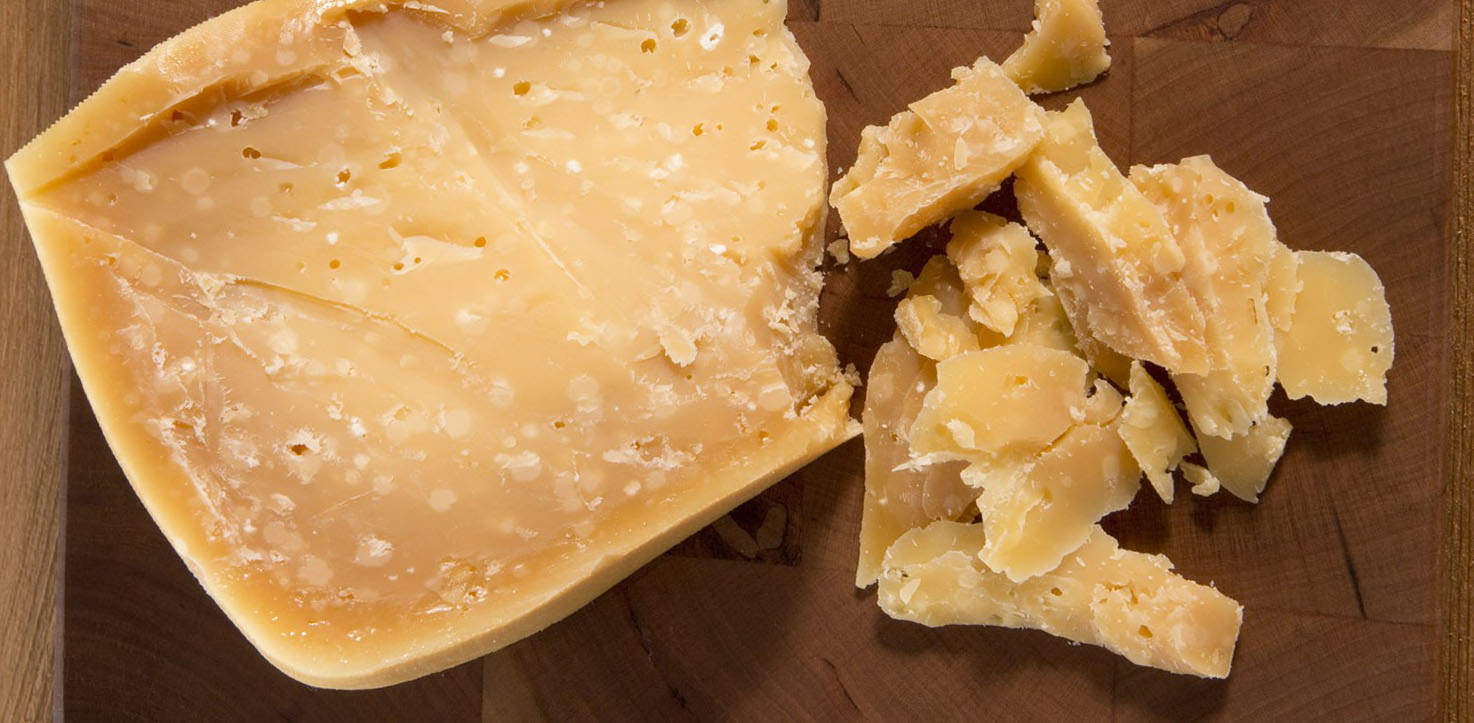
Post updated 3/29/22
Have you ever taken a bite of really aged cheese and found that it was a bit crunchy? What you’re tasting there are cheese crystals that form over a long period of time due to chemical and protein breakdowns and can vary in size, texture, and placement depending on the cheese. And while they may seem to make the cheese extra sweet or salty, they are neither sugar nor sodium. The science of proteolysis (dealing with proteins) is a little complicated, but like the proteins of a fine aged Gouda, we’re going to break it down nice and cheesy.

Photo via Serious Eats
When a cheese is formed, fats and proteins are grouped together in chains making up the curds. When the cheese ages, these protein chains eventually begin to unravel and leave behind small crunchy deposits that we know as cheese crystals. However, not all aged cheeses will develop crystals as their formation relies on a few different things.
Like any mineral crystal, the likelihood of cheese crystal formation is dependent on the kind of material (the types of proteins in a cheese) and the concentration of that material. The crystallization process begin when proteins, moving around in the serum or paste of the cheese, collide and form a nucleation site. This attracts more proteins, and the size of the crystals will grow.
There are two type of cheese crystals that can form in a cheese: Tyrosine and Calcium Lactate.
Tyrosine crystals form only in the interior of the cheese and are firm, bright white, and found in Swiss and Romano cheeses. Calcium Lactate crystals can form in both the interior of the cheese and on the surface. Typically, they are found in cheddar and Colby. These crystals are softer, paler, and appear more frequently than Tyrosine crystals. These two types of crystals can also appear alongside each other in certain cheeses like aged Parmigiano-Reggiano or Gouda. Differentiating between the two types of crystals is as easy as determining which crystal is a bit softer and paler and also matches the crystals on the surface of the cheese – that’s your calcium lactate.

Notice the calcium lactate on the surface of Hook’s Sharp Cheddar.
Many people confuse cheese crystals with mold or yeast growth. In the past, cheesemakers tried to avoid crystallization, concerned that their customers would not want a cheese that appeared unusually moldy. However, that’s all changing. These days cheese crystals are trendy and remain absolutely delicious. Crystals not only add extra crunch to cheese; they also indicate that the cheese will have a hearty and complex flavor. Even the American Cheese Society is pitching in by educating their judges on what to look for in crystallized cheeses, like an even distribution of crystals and a pleasant crunch.
Who knew unravelling protein chains could taste so delicious?
Feature Photo Credit: Murray’s Cheese



Great article
So how does someone new to the world of quality cheeses know if it’s cheese crystals or mold?
I 2nd Prairie Breeze!
Yum, the crunch of crystals in a truly sharp cheddar combined with the bite of the taste is just excellent. Thanks for the explanation.
Our pleasure!
Prairie Breeze!
Sheri Salomone says…”It’s not a meal unless these’s cheese”
I love the tiny crunchy crystals in Gouda Cheese! What a pleasant surprise.
#Charlie sheen # du winning ?
Found large white shiny crystals in my cheese,after eating a large piece, for a moment I thought a trip the hospital was needed as it had all the appearance of crack cocaine, and a strange taste,maybe a Columbian consignment had found its way into the shelves, I’m relived to find that they were cheese crystals,which I had never heard of till now,thought the value of the cheese just went down considerably from what I thought it was worth when I first discovered the shiny white deposits lol.
And i always thought the cheese with these white crystal is inedible would go in garbage.
Exactly why I lovvvvvve Belton Farm’s Red Fox!!
how about Prima Dona cheese? it does feel like there are delicious crystals inside…!